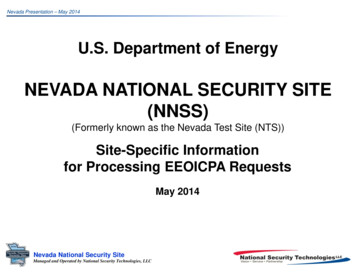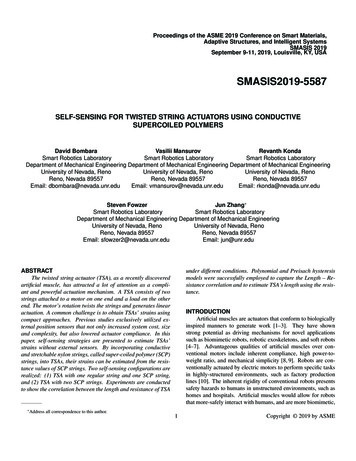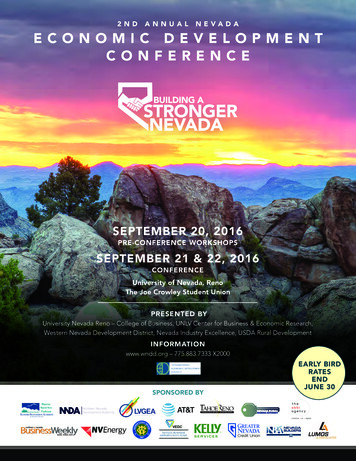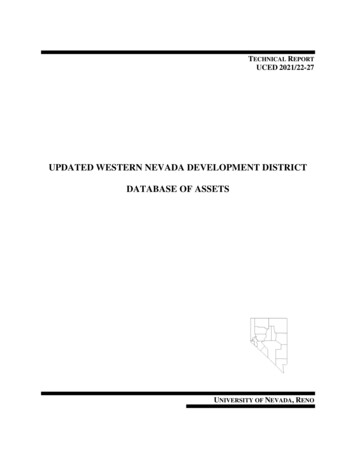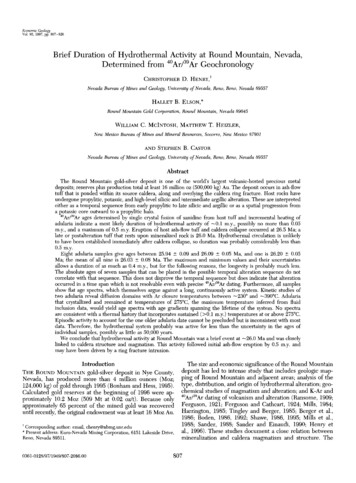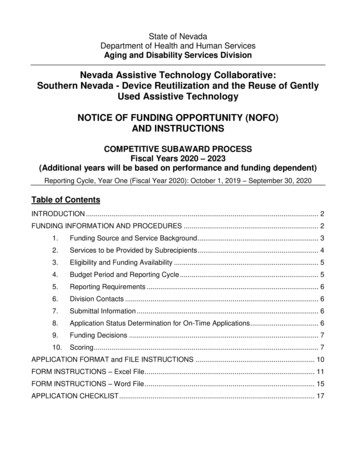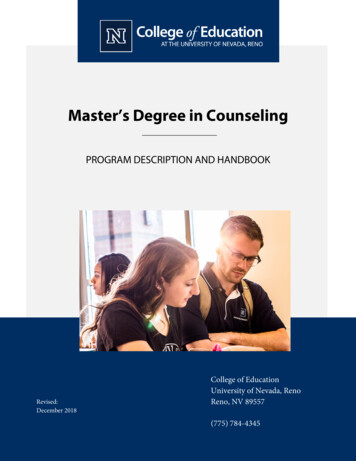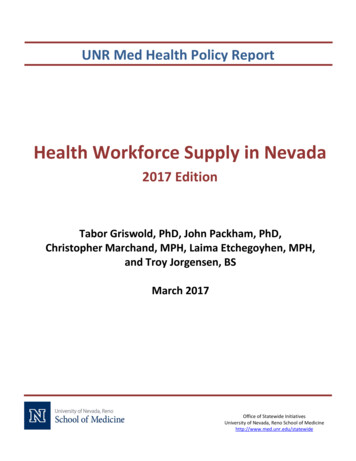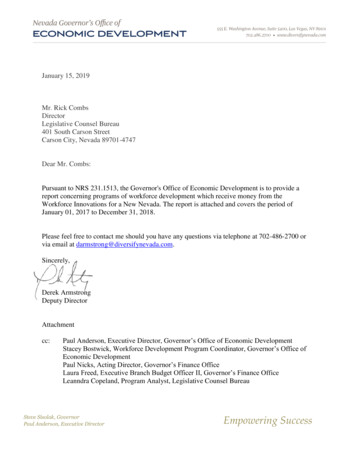
Transcription
Nevada College Governanceand Workforce AlignmentMay 9, 2014Greenspun Auditorium8:30 a.m -12:00 p.m.The Lincy Institute 2014
Community College Governance inNevada: An Evidence-BasedApproachMario MartinezProfessor of Higher Education, UNLVThe Lincy Institute 2014
Use an evidence‐based approach to explore Nevada’slandscape, higher education governance, and communitycollege performance. Draw on research, theory, and national and state‐level data. What are the implications for Governance? Study has nothing to say about political undertones, powerpreferences, or leadership. Recommendations are made to stimulate discussion, not asdefinitive conclusions.The Lincy Institute 2014
There is no one perfect solution for all states. Comparison among states provides ideas and will help usframe our thinking for Nevada. Transparency of analysis is best—reliance on jargon andcomplexity only confuses—keep it simple. Examine efficiency and effectiveness. Something that isefficient but not effective means resources are not optimized. I approach analysis with no agenda just calling “the balls andstrikes.”The Lincy Institute 2014
Centralized structures are effective in homogeneousenvironments With increased diversity and complexity, a balance ofcentralization and decentralization is necessary The different functions of governance may benefit from a“separation of duties” (metaphor of the bank) Organizational structure matters; it can influence institutionalbehavior and responsiveness and, ultimately, student successThe Lincy Institute 2014
Economic ProfileUrban: RuralInstitutionsEnrollmentsTypesThe Lincy Institute 2014 nity CollegeGovernanceChange Structure?Status bers
In Nevada: From 1970 ‐2010, the population increased 453% In just the first 10 years of the new millennium, Hispanicshave increased from 19.7% to 26.5% of the population. In the first 1o years of the new millennium, those identifyingas “White Alone” have decreased from 65.2% to 54.1% of thepopulation.The Lincy Institute 2014
In a 20 year span, from 1992‐2012: The two industries with the largest employment growthwere in Professional & Business Services and Education& Health Services Leisure & Hospitality remains the largest industry byemployment, but has also experienced the largestdecrease as a percentage of total employment inNevada. Government has slightly declined, as a percentage oftotal employment across all industriesThe Lincy Institute 2014
Highest state growth rate in terms ofenrollment, from 1970‐2010, at 733% Fourth highest growth rate in terms ofenrollment, from 1990‐2010. 28.8% minority student population in 2000compared to 46% in 2011The Lincy Institute 2014
Governing Board established in 1864as a centralized structure and hasremained so, with additionalinstitutions falling under its purviewThe Lincy Institute 2014
Economic ProfileUrban: RuralInstitutionsEnrollmentsTypesThe Lincy Institute 2014 nity CollegeGovernanceChange Structure?Status bers
2009 Metric forNevadaNevada NationalRankingComments/NotesCredentials andDegrees Per 1,000ResidentsCredentials andDegrees Per 100FTE Students15.49.3Credentials andDegrees Per 100,000 ofEducation andRelated Expenses1.2249th49th42ndResult down 6.6%from 2005Result up .4% from2005Nevada has steadilyimproved on thismetric. 2005 rankingwas 48th, and in 2010,the ranking is 38thAdditional information in report indicate two‐year institutions have also missed severalopportunities to take advantage of available federal funds and grants (e.g. TradeAdjustment Assistance Community College and Career Training Initiative)The Lincy Institute 2014
Interpretations and RecommendationsThe Lincy Institute 2014
INPUTSDemographicsRacial/EthnicNumbersEconomic ProfileUrban: RuralInstitutionsEnrollmentsTypesOUTPUTCommunity CollegePerformanceEvidence State population larger,more diverse Economy is diversifying Urban and rural needs aredifferent Institutional enrollmentsgrowing and more diverse Mission and goals forinstitutions should becomplementary but notduplicativeEvidence Existing metrics are notencouraging Some evidence that externalopportunities not optimizedChange Structure ‐DecentralizeStatus QuoChange Structure ‐DecentralizeStatus QuoTHEORYWhat doesOrganizationalTheory andGovernanceLiterature Say?The Lincy Institute 2014Evidence Separation of duties(coordination andgovernance) As complexity and sizeincrease, centralization is lesseffective Local needs and diverseurban environments requiresome customizationChange Structure ‐DecentralizeStatus Quo
Existing structure not optimal. Band‐aide solutions (e.g. spin‐off function within existingstructure) will not address the many issues outlined and willonly delay a long‐term answer. Confluence of analytical forces strongly suggest a change ingovernance should be on the table, with considerations fordecentralization and separation of duties.The Lincy Institute 2014
Status Quo: Leave things the same (analysis does not support this option),but don’t expect any changes in performance or outcomes. Create positions or functions within existing board to differentiatecommunity colleges (analysis does not support this option). Create local boards for community colleges, and embody an explicitcoordinating role to an existing body (not ideal, but heading in the rightdirection) Create local boards for community colleges and embody an explicitcoordinating role to a new body (best case, based on the analysis). Other ideas are possible, but recommendations should be evidence‐basedand not politically motivatedThe Lincy Institute 2014
Transparency is best—my report has everything clearlyspelled out, but I welcome criticisms and scrutiny of theanalysis (no smoke screens, nothing to hide). My agreement to do this analysis was largely driven by myphilosophy of “students first.” Viewpoints based on rhetoric or simply preserving existingprocesses and structures should be minimized—evidencebased, transparent analysis is best.The Lincy Institute 2014
Understanding Nevada’s HigherEducation Governance for Two-yearColleges: Challenges and SolutionsMagdalena MartinezDirector of Education Programs,The Lincy InstituteThe Lincy Institute 2014
Widening college access for allResponsive to local and regionalworkforce needs1947 Truman Commission ReportCommunity colleges today Vocational training College transfer Remedial educationThe Lincy Institute 2014
Governing BoardsCoordinating BoardsPlanning/Regulatory/ServiceAgencyNevada Constitution: Board ofRegents of the University ofNevadaThe Lincy Institute 2014
The Lincy Institute 2014
National Center for Education Statistics Integrated Postsecondary Education Data SystemCollegeTruckee Meadows Community CollegeCollege of Southern NevadaWestern Nevada CollegeGreat Basin CollegeNevada State CollegesUniversity of Nevada, RenoUniversity of Nevada, Las VegasSectorPublic, 2‐yearPublic, 4‐year or abovePublic, 4‐year or abovePublic, 4‐year or abovePublic, 4‐year or abovePublic, 4‐year or abovePublic, 4‐year or aboveSource: U.S. Department of Education, IPEDS, 2014.The Lincy Institute 2014
StatePopulation inmillions (2012)Public Two‐YearColleges in StatePublic Two‐YearCollege per CapitaIowaArkansasMississippiKansasUtahNevadaNew 93,333112,000400,0002.7 million105,263Source: US Census Bureau, 2012; U.S. Department of Education, IPEDS, 2014.The Lincy Institute 2014
IowaKansasUtahNationNew MexicoMississippiArkansasNevadaPercent Estimate, Associates Degree 474950Source: National Center for Higher Education Management Systems (MCHEMS).The Lincy Institute 2014
100 Students50% Graduatefrom HighSchool51% EnterCollegeImmediatelyafter HighSchool13% Enroll FullTime in Two‐Year CollegeSource: NCES, Common Core Data; IPEDS Residency and Migration, FallEnrollment, and Graduation Rate Surveys, 2010.The Lincy Institute 201416.7% Graduatewith a Two‐YearDegree in 3Years
StateNew aState and Local Support per Full‐TimeStudent ( )77917081629058105531552553384884Source: NCHEMS, Revenues and Support, 2011.The Lincy Institute 2014Rank7112730313340
StateState‐level Governance orCoordination w MexicoState‐level coordinationState‐level coordinationState‐level coordinationState‐level coordinationState‐level governanceState‐level governanceState‐level coordinationSeparate Two‐YearGovernance orCoordinatingStructureYesYesYesYesNoNoYesLocal funding,% from local sources24.29.815.844.10036.1Source: Education Commission of the States; McGuinness, 2014.The Lincy Institute 2014
Align the state’s public colleges with the U.S.Department of Education federal definitions and theNevada ConstitutionEthic of Local Community Create a statewide coordinating structure that has oversightfor local college governing boards in order to improveworkforce alignment, transparency, and outcomes in Nevada Local governing boards should have the autonomy to accesslocal and federal fundingThe Lincy Institute 2014
The Case for a New CollegeGovernance Structure in Nevada:Integrating Higher Education withEconomic DevelopmentDavid DamoreAssociate Professor of Political Science, UNLVThe Lincy Institute 2014
Across the nation, cities and metros aretaking control of their own destinies,becoming deliberate about their economicgrowth. Power is devolving to the placesand people who are closest to the groundand oriented toward collaborative action.This shift is changing the nature of ourleadership – who our leaders are, what theydo, and how they govern.The Lincy Institute 2014
“One Nevada” is a poor fit for the state’seconomic challenges Identified opportunities for economicdevelopment and diversification Mapped industry sectors to regions Empowered regional development authorities(RDAs) to position, market, and coordinateeconomic activity Next step: extending the GOED model to highereducationThe Lincy Institute 2014
A long standing priority The 1862 Morrill Act provided resources for land grantuniversities The 2 billion Trade Adjustment Assistance CommunityCollege and Career Training Grants The Knowledge Fund The SB391 Study CommitteeThe Lincy Institute 201432
States vary in how they integrate higher education andeconomic development Governance of higher education is a manifestation of a state’shistory, priorities, and prior reforms Where reform has occurred governance reflects the tensionsand negotiations between regions, localities, and statepriorities In Nevada there has been little to no innovationThe Lincy Institute 201433
The Lincy Institute 2014A consolidated,statewide structureLittle connection tothe constitutionallyprescribed creationof “a StateUniversity” governedby “a Board ofRegents”34
Consequences (beyond outcomes) The same policies and processes are applied to institutionswith vastly different missions Limits or excludes involvement by localities in areas that arelocal by nature By conflating governance by the Board of Regents of theUniversity of Nevada with administration by the NevadaSystem of Higher Education (NSHE) the state is vulnerable tolitigationThe Lincy Institute 201435
The Lincy Institute 2014Two tierstructureLegislativeoversightRecognizesand empowerslocalities36
ControllingGovernanceAuthorityAdministration InstitutionsThe Lincy Institute 2014Board of Regents of the University ofNevadaElected from districts to six year terms;maximum of two termsNevada ConstitutionExecutive with Legislative oversightUniversity of NevadaUniversity of Nevada System Office(UNSO)Locations: Reno and Las Vegas37
The Lincy Institute 201438
New LegislationExecutive with Legislative oversightThe Lincy Institute 2014InstitutionsState Governance:11 member board appointed by the Legislatureto four year terms from three regions (eightfrom Southern Nevada; two from greater Reno;and one rural)Local Governance:Seven member boards, including one student,for each institution nominated by localgovernments and selected by the Legislature tofour year termsPublic:Two‐ and Four‐Year State Collegesand Community CollegesPrivate:Not‐For Profit and For‐ProfitInstitutionsNevada Office of Higher overnanceNevada Office of Higher Education (NOHE) Stateand Local BoardsLocations: Carson City, Elko, and LasVegasDistricts:1) Las Vegas Combined StatisticalArea2) Reno Combined Statistical Area3) Rural39
District 3District 2District12013 District PopulationNevadaThe Lincy Institute 2014Las 21%)Rural(5%)2,064,309590,428135,3992013 County PopulationClark2,027,868Southern Nye36,441Carson t17,363Lander6,032Lincoln5,245Mineral4,614Northern Nye5,856Pershing6,877White Pine10,0572,790,13640
NOHE State Board and the NOHE Coordinate local institutions with regional and state economicdevelopment efforts Absorb the functions of the Commission on PostsecondaryEducation (CPE) In 2013, 141 licensed for‐ and not‐for profit postsecondaryinstitutions paid a total of 112,564 to access the Nevada market Funding and staffing Transfer relevant CPE and NSHE staffing and funding In 2014, system administration is consuming over 180 full‐timeemployees and 27 million in general fund revenueThe Lincy Institute 201441
Existing public institutions Establish governing boards with nominees from GOED RDAs,business interests, community groups, local governments, andstudent representatives District activity Establish stakeholder groups Develop Requests for Proposal and district master plansidentifying the institutions that the districts want to developThe Lincy Institute 201442
To dismantle any existing public institution of highereducationTo place two‐ and four‐year colleges under theexclusive control of local governmentsTo replace existing funding from the state general fundwith local resourcesTo create a larger administrative bureaucracy thanpresently existsThe Lincy Institute 201443
Structures shape outcomes Changing outcomes requires innovative administrative andgovernance structures Most states use a mix of structures to administer, govern, anddeliver higher education GOED demonstrates that the status quo can be changed for thebetter Present arrangements do not comply with the NevadaConstitution and they are not aligned with the state’seconomic development effortsThe Lincy Institute 201444
Degrees Per 100 FTE Students Credentials and Degrees Per 100,000 of Education and Related Expenses 2009 Metric for Nevada 15.4 9.3 1.22 . Great Basin College Public,4‐yearorabove Nevada State Colleges Public,4‐yearorabove University of Nevada, Reno Public,4‐yearorabove University of Nevada, Las Vegas Public,4‐yearorabove .
